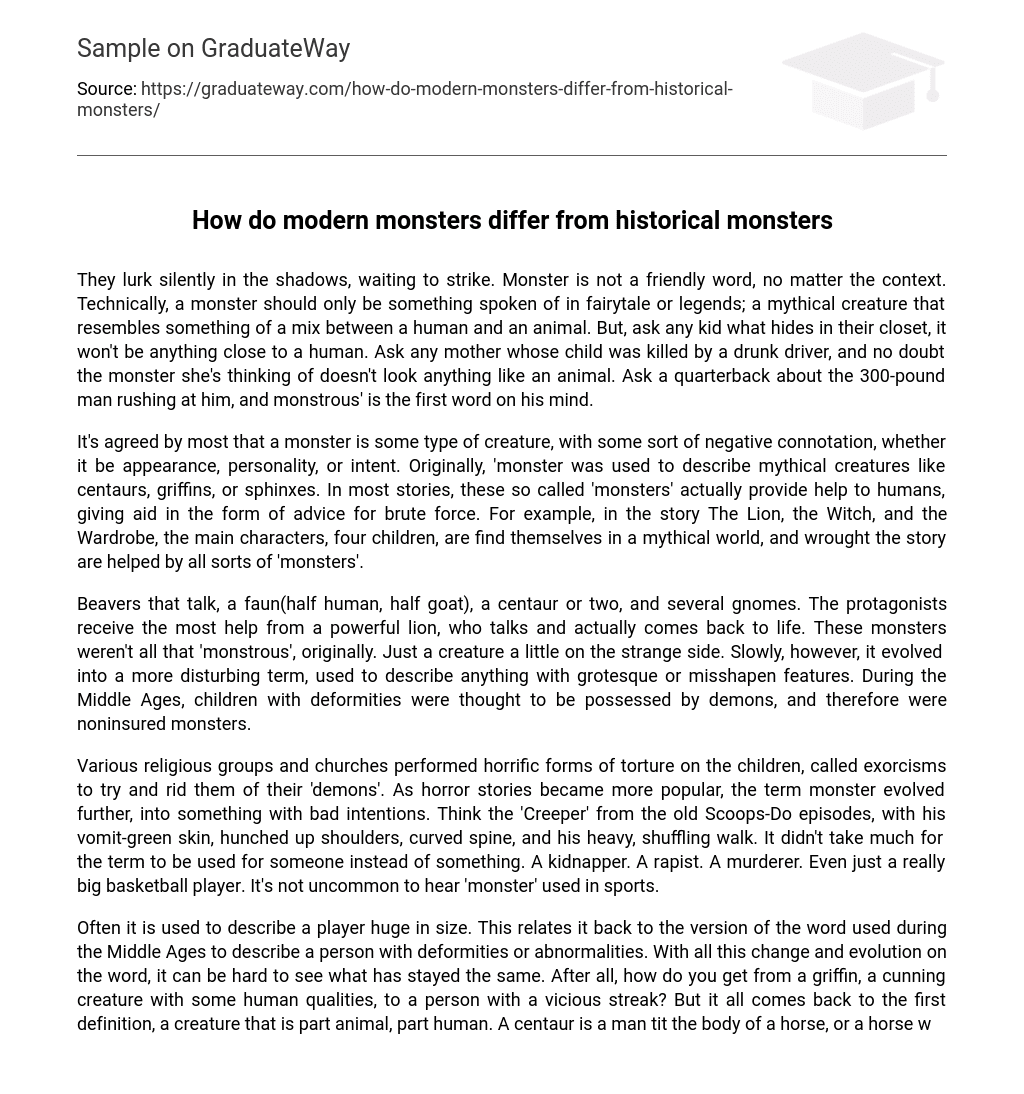They lurk silently in the shadows, waiting to strike. Monster is not a friendly word, no matter the context. Technically, a monster should only be something spoken of in fairytale or legends; a mythical creature that resembles something of a mix between a human and an animal. But, ask any kid what hides in their closet, it won’t be anything close to a human. Ask any mother whose child was killed by a drunk driver, and no doubt the monster she’s thinking of doesn’t look anything like an animal. Ask a quarterback about the 300-pound man rushing at him, and monstrous’ is the first word on his mind.
It’s agreed by most that a monster is some type of creature, with some sort of negative connotation, whether it be appearance, personality, or intent. Originally, ‘monster was used to describe mythical creatures like centaurs, griffins, or sphinxes. In most stories, these so called ‘monsters’ actually provide help to humans, giving aid in the form of advice for brute force. For example, in the story The Lion, the Witch, and the Wardrobe, the main characters, four children, are find themselves in a mythical world, and wrought the story are helped by all sorts of ‘monsters’.
Beavers that talk, a faun(half human, half goat), a centaur or two, and several gnomes. The protagonists receive the most help from a powerful lion, who talks and actually comes back to life. These monsters weren’t all that ‘monstrous’, originally. Just a creature a little on the strange side. Slowly, however, it evolved into a more disturbing term, used to describe anything with grotesque or misshapen features. During the Middle Ages, children with deformities were thought to be possessed by demons, and therefore were noninsured monsters.
Various religious groups and churches performed horrific forms of torture on the children, called exorcisms to try and rid them of their ‘demons’. As horror stories became more popular, the term monster evolved further, into something with bad intentions. Think the ‘Creeper’ from the old Scoops-Do episodes, with his vomit-green skin, hunched up shoulders, curved spine, and his heavy, shuffling walk. It didn’t take much for the term to be used for someone instead of something. A kidnapper. A rapist. A murderer. Even just a really big basketball player. It’s not uncommon to hear ‘monster’ used in sports.
Often it is used to describe a player huge in size. This relates it back to the version of the word used during the Middle Ages to describe a person with deformities or abnormalities. With all this change and evolution on the word, it can be hard to see what has stayed the same. After all, how do you get from a griffin, a cunning creature with some human qualities, to a person with a vicious streak? But it all comes back to the first definition, a creature that is part animal, part human. A centaur is a man tit the body of a horse, or a horse with the torso of a man.
That connection is easy enough. But a murderer is a person, at least from the outside. On the inside, though, maybe not so much. Human beings are different from other animals because of our ability to feel, to follow a set of morals that we decide for ourselves. There are a set of morals generally accepted by a society, and not killing people is probably at the top of most lists in modern times. A murderer somehow overrides our natural laws and takes on an annalistic mindset, killing for a number reasons, like revenge, anger, or sometimes even just to kill.
Lions attack any foreign lion that threatens their pride. Get enough adrenaline pumping through a wolf pack’s veins, and they’re unstoppTABLE in an attack. Show a shark a wounded or weak animal, and they won’t think twice about going in for the kill. In the same sense, a kidnapper takes a helpless child from its home, putting it in danger. It goes against natural human instinct to put any child in danger. So, even though people like this don’t have the body of a horse, or horns, or anything of that nature, they still have an animal side, hiding on under the surface. Live the evolution of the word find its roots in human nature itself. As human nature evolved, and our understanding of the sciences and the technological world, we stopped referring back so much that first definition. Animals stopped being thought of as possessing human qualities, except for in story books, and there, in lies the change. Society removed its emphasis of human qualities in animals, and that left a gap in our collective imaginations. That provided room for the subtle shift that changed the definition, as society began placing annalistic qualities on people.
Because of this, we also admitted, however unintentionally, that monster affect us personally, and that they were no longer childish fairy tales. Really, the word monster isn’t all that different from what it once was. Time has just slightly altered its meaning, or changed to whom the word applies. A monster can still be an imaginary beast creeping in a closet, or lying in wait beneath a child’s bed, preparing to occupy their nightmares. But don’t be fooled. There are also very real monsters lurking out there, in the real world. And they usually look just like you and me.





